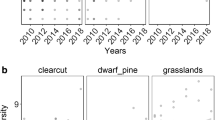Abstract
How plant communities in Anatolian steppes recover after disturbances has remained unknown. To study the effects of small-scale disturbances on plant communities of the central Anatolian steppe, we established thirty-two plots 1 × 1 m in size in a natural steppe near Ankara (Turkey). The plots were subjected to mowing or hoeing treatments representing low- and high-intensity disturbance, respectively. Some plots were left untreated to serve as the control. The plots were sampled for three consecutive years to investigate changes in species occurrence, cover and biomass under various disturbance frequencies and intensities over time. The vegetation was able to recover within a few months, particularly in the growing season after mowing treatments, but the recovery level of the vegetation was lower after hoeing, especially when it was applied with high frequency. Species richness and cover of annual herbs increased with moderate disturbance frequencies in both disturbance types whereas perennial herbs were negatively affected by the hoeing disturbance, but not by the mowing disturbance. Both types of disturbance had a significant negative effect on plant aboveground biomass in the plots. The results partly support the intermediate disturbance hypothesis. High-level resilience to small-scale disturbances was observed, possibly due to adaptations of Anatolian steppe plants to natural and anthropogenic disturbances.




Similar content being viewed by others
References
Alınoğlu N (1971) Devamlı otlatma ve çeşitli sürelerle dinlendirmenin mera vejetasyonuna etkisi üzerinde araştırmalar. No. 16.Çayır-Mera ve Zootekni Araştırma Enstitüsü Yayınları, Ankara (in Turkish)
Ambarlı D, Zeydanlı US, Balkız Ö, Aslan S, Karaçetin E, Sözen M et al. (2016) An overview of biodiversity and conservation status of steppes of the Anatolian Biogeographical Region. Biodivers & Conservation 25:2491–2519
Armesto JJ, Pickett STA (1985) Experiments on disturbance in old-field plant communities: impact on species richness and abundance. Ecology 66:230–240
Bartoń K (2020) MuMIn: multi-model inference. R package version 1.43.17. Available at https://CRAN.R-project.org/package=MuMIn
Bates D, Maechler M, Bolker B, Walker S (2015) Fitting linear mixed-effects models using lme4. J Statist Softw 67:1–48
Bond WJ (2019) Open ecosystems: ecology and evolution beyond the forest edge. Oxford University Press.
Bonet A (2004) Secondary succession of semi-arid Mediterranean old-fields in south-eastern Spain: insights for conservation and restoration of degraded lands. J Arid Environm 56:213–233
Burke MJ, Grime JP (1996) An experimental study of plant community invasibility. Ecology 77:776–790
Büyükburç U (1983) Ankara ili Yavrucak Köyü meralarının gübreleme ve dinlendirme yolu ile ıslahı olanakları üzerinde bir araştırma. Çayır Mera ve Zootekni Araştırma Enstitüsü Yay.No.79, Ankara. (in Turkish)
Camci-Çetin S, Karaca A, Haktanir K, Yildiz H (2007) Global attention to Turkey due to desertification. Environm Monit Assessm 128:489–493
Carbutt C, Henwood WD, Gilfedder LA (2017) Global plight of native temperate grasslands: going, going, gone? Biodivers & Conservation 26:2911–2932
Carmel Y, Kadmon R (1999) Effects of grazing and topography on long-term vegetation changes in a Mediterranean ecosystem in Israel. Pl Ecol 145:243–254
Coffin DP, Lauenroth WK (1988) The effects of disturbance size and frequency on a shortgrass plant community. Ecology 65:1609–1617
Collins SL (2000) Disturbance frequency and community stability in native tallgrass Prairie. Amer Naturalist 155:311–325
Connell JH (1978) Diversity in rain forests and coral reefs. Science 199:1302–1310
Coughenour MB (1985) Graminoid responses to grazing by large herbivores: adaptations, exaptations, and interacting processes. Ann Missouri Bot Gard 72:852–863
Cramer VA, Hobbs RJ, Standish RJ (2008) What’s new about old fields? Land abandonment and ecosystem assembly. Trends Ecol Evol 23:104–112
Davis PH (ed.) (1965–1985) Flora of Turkey and the East Aegean Islands. Vols. 1-9. Edinburgh University Press, Edinburgh
Dantas VDL, Hirota M, Oliveira RS, Pausas JG (2016) Disturbance maintains alternative biome states. Ecol Letters 19:12–19
Ergüner Y, Kumar J, Hoffman FM, Dalfes HN, Hargrove WW (2019) Mapping ecoregions under climate change: a case study from the biological ‘crossroads’ of three continents, Turkey. Landscape Ecol 34:35–50
Feng Y, Lu Q, Tokola T, Liu H, Wang X (2009) Assessment of grassland degradation in Guinan county, Qinghai Province, China, in the past 30 years. Land Degrad Developm 20:55–68
Fırıncıoğlu HK, Seefeldt SS, Şahin B (2007) The effects of long-term grazing exclosures on range plants in the Central Anatolian Region of Turkey. Environm Managem 39:326–337
Fırıncıoğlu HK, Şahin B, Seefeldt SS, Mert F, Hakyemez BH et al. (2008) Pilot study for an assessment of vegetation structure for steppe rangelands of Central Anatolia. Turk J Agric Forest 32:401–414
Fırıncıoğlu HK, Seefeldt SS, Şahin B, Vural M (2009) Assessment of grazing effect on sheep fescue (Festuca valesiaca) dominated steppe rangelands, in the semi-arid Central Anatolian region of Turkey. J Arid Environm 73:1149–1157
Fırıncıoğlu HK, Adıgüzel N, Bani B, Şahin B (2010) Assessment of grazing effect on two subschrubs (Astragalus schottianus and Thymus spyleus) dominated Mountain Bozoğlan grasslands in the semi-arid central-southern Anatolian Region of Turkey. Arid Land Res Managem 24:282–300
Grime JP (1977) Evidence for the existence of three primary strategies in plants and its relevance to ecological and evolutionary theory. Amer Naturalist 111:1169–-1194
Güner A, Aslan S, Ekim T, Vural M, Babaç MT (Eds.) (2012) Türkiye Bitkileri Listesi (Damarlı Bitkiler). Nezahat Gökyiğit Botanik Bahçesi ve Flora Araştırmaları Derneği yayını, İstanbul, pp 292 (in Turkish)
Hart RH (2001) Plant biodiversity on shortgrass steppe after 55 years of zero, light, moderate, or heavy cattle grazing. Pl Ecol 155:111–118
Helm J, Dutoit T, Saatkamp A, Bucher SF, Leiterer M et al. (2019) Recovery of Mediterranean steppe vegetation after cultivation: legacy effects on plant composition, soil properties and functional traits. Appl Veg Sci 22:71–84
Hobbs RJ, Atkins L (1991) Interactions between annuals and woody perennials in a Western Australian nature reserve. J Veg Sci 2:643–654
Hobbs RJ, Huenneke LF (1992) Disturbance, diversity, and invasion: Implications for conservation. Conservation Biol 6:324–337
Kurt L, Tuğ GN, Ketenoğlu O (2006) Synoptic view of steppe vegetation of Central Anatolia (Turkey). Asian J Pl Sci 5:733–739
Kürschner H, Parolly G (2012) The Central Anatolian Steppe. In Werger MJA, van Staalduinen MA (eds) Eurasian steppes. Ecological problems and livelihoods in a changing world. Plant and vegetation 6. Springer, pp 149–171
Lavorel S, Lepart J, Debussche M, Lebreton JD, Beffy JL (1994) Small scale disturbances and the maintenance of species diversity in Mediterranean old fields. Oikos 70:455–473
MacDougall AS, McCann KS, Gellner G, Turkington R (2013) Diversity loss with persistent human disturbance increases vulnerability to ecosystem collapse. Nature 494:86–89
Mack RN, Thompson JN (1982) Evolution in steppe with few large, hooved mammals. Amer Naturalist 119:757–773
McIntyre S, Lavorel S, Tremont RM (1995) Plant life-history attributes: their relationship to disturbance response in herbaceous vegetation. J Ecol 83:31–44
McIntyre S, Lavorel S, Landsberg J, Forbes TDA (1999) Disturbance response in vegetation—towards a global perspective on functional traits. J Veg Sci 10:621–630
McLaughlin A, Mineau P (1995) The impact of agricultural practices on biodiversity. Agric Eco-Syst Environm 55:201–212
Merou TP, Tsiftsis S, Papanastasis VP (2013) Disturbance and recovery in semi-arid Mediterranean grasslands. Appl Veg Sci 16:417–425
Mittermeier RA, Robles Gil P, Hoffmann M, Pilgrim J, Brooks T et al. (2004) Hotspots revisited: Earth’s biologically richest and most endangered ecoregions. CEMEX, Mexico City, Mexico
O’Connor RC, Taylor JH, Nippert JB (2020) Browsing and fire decreases dominance of a resprouting shrub in woody encroached grassland. Ecology 101:e02935
Oksanen J, Blanchet FG, Friendly M, Kindt R, Legendre P et al. (2018) vegan: community ecology package. R package version 2.4-6. Available at https://CRAN.R-project.org/package=vegan
Overbeck GE, Müller SC, Pillar VD, Pfadenhauer J (2005) Fine-scale post-fire dynamics in southern Brazilian subtropical grassland. J Veg Sci 16:655–664
Pausas JG, Lavorel S (2003) A hierarchical deductive approach for functional types in disturbed ecosystems. J Veg Sci 14:409–416
Pausas JG, Keeley JE (2014) Evolutionary ecology of resprouting and seeding in fireprone ecosystems. New Phytol 204:55–65
Pausas JG, Paula S (2020) Grasses and fire: the importance of hiding buds. New Phytol 226:957–959
R Core Team (2021) R: A language and environment for statistical computing, R Foundation for Statistical Computing, Vienna, Austria. Available at https://www.R-project.org
Ratajczak Z, Nippert JB, Collins SL (2012) Woody encroachment decreases diversity across North American grasslands and savannas. Ecology 93:697–703
Rees M, Long MJ (1992) Germination biology and the ecology of annual plants. Amer Naturalist 139:484–508
Şekercioğlu ÇH, Anderson S, Akçay E, Bilgin R, Can ÖE et al. (2011) Turkey's globally important biodiversity in crisis. Biol Conservation 144:2752–2769
Sloan S, Jenkins CN, Joppa LN, Gaveau DL, Laurance WF (2014) Remaining natural vegetation in the global biodiversity hotspots. Biol Conservation 177:12–24
Smith AL, Barrett RL, Milner RN (2018) Annual mowing maintains plant diversity in threatened temperate grasslands. Appl Veg Sci 21:207–218
Stearns SC (1976) Life-history tactics: a review of the ideas. Quart Rev Biol 51:3–47
Sternberg M, Gutman M, Perevolotsky A, Ungar ED, Kigel J (2000) Vegetation response to grazing management in a Mediterranean herbaceous community: a functional group approach. J Appl Ecol 37:224–237
Strauss SY, Agrawal AA (1999) The ecology and evolution of plant tolerance to herbivory. Trends Ecol Evol 14:179–185
Tavşanoğlu Ç, Çatav ŞS, Özüdoğru B (2015) Fire-related germination and early seedling growth in 21 herbaceous species in Central Anatolian steppe. J Arid Environm 122:109–116
Tavşanoğlu Ç (2017) Disturbance regimes proceeding in Anatolian steppe ecosystems. Kebikeç 43:259–288 (in Turkish with English abstract)
Török P, Vida E, Deák B, Lengyel S, Tóthmérész B (2011) Grassland restoration on former croplands in Europe: an assessment of applicability of techniques and costs. Biodivers & Conservation 20:2311–2332
Török P, Ambarlı D, Kamp J, Wesche K, Dengler J (2016) Step(pe) up! Raising the profile of the Palaearctic natural grasslands. Biodivers & Conservation 25:2187–2195
Van Auken OW (2009) Causes and consequences of woody plant encroachment into western North American grasslands. J Environm Managem 90:2931–2942
Vural M, Adıgüzel N (2006). Bozkırlar. In Eken G, Bozdoğan M, İsfendiyaroğlu S, Kılıç DT, Lise Y (eds) Türkiye’nin Önemli Doğa Alanları. Doğa Derneği, Ankara, Turkey, pp 28–30 (in Turkish)
Wickham H (2016) ggplot2: elegant graphics for data analysis. Springer-Verlag New York
World Wildlife Fund, Mark McGinley (2008) Central Anatolian steppe In Cleveland CJ (ed) Encyclopedia of Earth. Environmental Information Coalition, National Council for Science and the Environment, Washington, D.C. Available at http://www.eoearth.org/article/Central_Anatolian_steppe
Yuan ZY, Jiao F, Li YH, Kallenbach RL (2016) Anthropogenic disturbances are key to maintaining the biodiversity of grasslands. Sci Rep 6:22132
Zhang J, Huang Y, Chen H, Gong J, Qi Y et al. (2018) Response of plant functional traits at species and community levels to grazing exclusion on Inner Mongolian steppe, China. Rangeland J 40:179–189
Zohary M (1973) Geobotanical foundations in the Middle East, vol. 1–2. G Fischer Verlag, Studgart, Germany
Acknowledgements
We thank Golshan Zare, D. Deniz Kazancı, Samet Ekincik, Kürşat Ekincik, Z. Tuğçe Yücens, Enes Işık and S. Nur Erdem for helping the fieldwork, and Can Elverici for laboratory studies. We also thank Jitka Klimešová and two anonymous reviewers for their constructive comments on the paper. The identification of plant samples was done at the Hacettepe University Herbarium (HUB). This study was supported by The Rufford Small Grants Foundation (project No. 12078-1). This paper is part of the requirements for the M.Sc. thesis by the first author submitted to Hacettepe University. The experiments we performed in this study comply with the current laws of Turkey.
Author information
Authors and Affiliations
Contributions
Çağatay Tavşanoğlu conceptualized and designed the study. All authors contributed to data collection in the field. Özlem Özüdoğru performed the laboratory work. Barış Özüdoğru identified plant taxa in the herbarium. Özlem Özüdoğru and Barış Özüdoğru prepared laboratory and field data for further analyses. Çağatay Tavşanoğlu analysed the data. Özlem Özüdoğru and Barış Özüdoğru wrote the first draft of the manuscript. All authors critically contributed to and approved the final version of the manuscript.
Corresponding author
Additional information
Publisher’s Note
Springer Nature remains neutral with regard to jurisdictional claims in published maps and institutional affiliations.
Supplementary Information
ESM 1
(PDF 634 kb)
Rights and permissions
About this article
Cite this article
Özüdoğru, Ö., Özüdoğru, B. & Tavşanoğlu, Ç. Recovery of a plant community in the central Anatolian steppe after small-scale disturbances. Folia Geobot 56, 241–254 (2021). https://doi.org/10.1007/s12224-021-09404-9
Received:
Revised:
Accepted:
Published:
Issue Date:
DOI: https://doi.org/10.1007/s12224-021-09404-9




